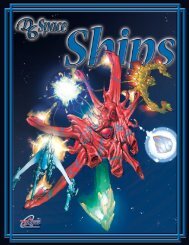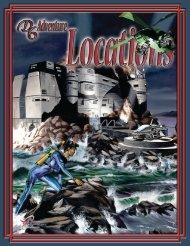Roosevelt mobilized the country and declared war on the AxisPowers, it seemed as if he spoke to each citizen <strong>in</strong>dividually.Therefore, accord<strong>in</strong>g to the Indians' way of perceiv<strong>in</strong>g, all mustbe allowed to participate. About 40,000 Indian men and women,aged 18 to 50, left reservations for the first time to f<strong>in</strong>d jobs <strong>in</strong>defense <strong>in</strong>dustries. This migration led to new vocational skills and<strong>in</strong>creased cultural sophistication and awareness <strong>in</strong> deal<strong>in</strong>gs withnon-Indians.The purchase of Treasury Stamps and Bonds by Indian tribes and<strong>in</strong>dividuals was considerable. By 1944, war bond sales to Indianshad reached $50 million. Indians also made generous donations tothe Red Cross and other organizations, giv<strong>in</strong>g what they had. Allof this from a m<strong>in</strong>ority group at the bottom rung of the economicladder.Some 2,500 Navajos helped construct the Fort W<strong>in</strong>gate OrdnanceDepot <strong>in</strong> New Mexico, and Pueblo Indians helped build the NavalSupply Depot <strong>in</strong> Utah. Because of their hunt<strong>in</strong>g, survival, andnavigational skills <strong>in</strong> the harsh regions of the north, AlaskanIndians were <strong>in</strong>volved <strong>in</strong> territorial defense. The entire footballteam at the Santa Fe Indian School volunteered for the armedforces after the 1942 homecom<strong>in</strong>g game.Women took over traditional men' s duties on the reservation,mann<strong>in</strong>g fire lookout stations, and becom<strong>in</strong>g mechanics,lumberjacks, farmers, and delivery personnel. Indian women,although reluctant to leave the reservation, worked as welders <strong>in</strong>aircraft plants. Many Indian women gave their time as volunteersfor American Women's Volunteer Service, Red Cross, and CivilDefense. They also tended livestock, grew victory gardens,canned food, and sewed uniforms. A wealthy Kiowa woman <strong>in</strong>Oklahoma sent a $1,000 check to the Navy Relief signed with herthumbpr<strong>in</strong>t. Alaskan women trapped animals to earn war bondmoney. By 1943, the YWCA (Young Women's ChristianAssociation) estimated that 12,000 young Indian women had leftthe reservation to work <strong>in</strong> defense <strong>in</strong>dustries. By 1945, anestimated 150,000 <strong>Native</strong> <strong>Americans</strong> had directly participated <strong>in</strong><strong>in</strong>dustrial, agricultural, and military aspects of the American wareffort.46
The Indian Service sent 1,119 of its 7,000 employees <strong>in</strong>to militaryservice. Of these, 22 died, while 7 won Silver or Bronze Stars. In1942, the Japanese captured 45 Aleuts on Attu. Only 24 returnedfrom captivity <strong>in</strong> Japan, where they had worked <strong>in</strong> clay pits.The federal government designated some Indian lands and eventribes themselves as essential natural resources, appropriat<strong>in</strong>gtribal m<strong>in</strong>erals, lumber, and lands for the war effort. After the war,<strong>Native</strong> <strong>Americans</strong> discovered that their service for the war efforthad depleted their resources without reward. Indian landsprovided essential war materials such as oil, gas, lead, z<strong>in</strong>c,copper, vanadium, asbestos, gypsum, and coal. The ManhattanProject used Navajo helium <strong>in</strong> New Mexico to make the atomicbomb. The war effort depleted the Blackfeet's tribal resources ofoil.Tell it to the Mar<strong>in</strong>esGerman soldiers dur<strong>in</strong>g <strong>World</strong> <strong>War</strong> I had been befuddled byIndians who transmitted messages over field phones <strong>in</strong> theChoctaw language. The 32d Infantry Division, Third Army, usedIndians from Michigan and Wiscons<strong>in</strong> to work with microphonesand to transmit messages <strong>in</strong> the Louisiana Maneuvers of 1940.Dur<strong>in</strong>g <strong>World</strong> <strong>War</strong> <strong>II</strong>, the U.S. Mar<strong>in</strong>e Corps recruited NavajoIndians for the same purpose. Navajo mar<strong>in</strong>es used their languageas a battlefield code that the Japanese never broke. The NavajoCode Talkers became the most celebrated and publicized of theradio units.Mar<strong>in</strong>es were "elite" fighters and welcomed Indians because oftheir warrior reputation. The Navajo mar<strong>in</strong>es ended theirceremonial chants by s<strong>in</strong>g<strong>in</strong>g the Mar<strong>in</strong>e Corps Hymn <strong>in</strong> Navajo.Their eloquence came naturally to Indians because theirs is anoral culture. Navajos formed special all-Navajo Mar<strong>in</strong>e Corpssignal units that encoded messages <strong>in</strong> their native tongue. Tak<strong>in</strong>gadvantage of the flexibility and range of the Navajo language,they worked out translations of military and naval terms so thatorders and <strong>in</strong>structions could be transmitted by voice over theradio <strong>in</strong> a code the Japanese were never able to break. They were47
- Page 3 and 4: PATHFINDERa conversation with Buck
- Page 5: CONTENTS20 th Century WarriorsNativ
- Page 9 and 10: A Long Tradition Of ParticipationAm
- Page 11 and 12: Native Americans As WarriorsAs the
- Page 13 and 14: what war was like. We talked about
- Page 17: “That Is the Way It Is”a conver
- Page 20 and 21: and this one only as a favor to his
- Page 22: could do it. It hits me something f
- Page 25: We trained in England with the Engl
- Page 28 and 29: somewhere between there we met the
- Page 30 and 31: helped me to keep going; you would
- Page 32 and 33: Of course he passed away. One of hi
- Page 34 and 35: to go and even talk to one of them
- Page 36 and 37: can teach me something. If I just l
- Page 39: Native Americansin World War IIby T
- Page 42 and 43: Distinguished Service Crosses, and
- Page 44: America's call for soldiers because
- Page 49 and 50: The Warriors and War Workers Return
- Page 51 and 52: Oklahoma Comanche Indians to be par
- Page 53 and 54: PathfindersConcept and TrainingTo a
- Page 55 and 56: either its amber halophane lights o
- Page 57 and 58: The 82 nd Airborne During World War
- Page 59 and 60: Once the beachhead was secured, the
- Page 61 and 62: parachute infantry regiments and re
- Page 63 and 64: penetration in the American lines.
- Page 66 and 67: The material in this pamphlet was c
- Page 69 and 70: Indians in the WarHonor for Indian
- Page 71 and 72: Honor for Indian HeroismThe war has
- Page 73 and 74: Distinguished Flying CrossThe highe
- Page 75 and 76: withering fire into the enemy, infl
- Page 77 and 78: cool courage and outstanding abilit
- Page 79 and 80: Then he solemnly shook the proffere
- Page 81 and 82: concrete that was once considered a
- Page 83 and 84: New York, made a similar jump and l
- Page 85 and 86: Foresight and Sound DecisionThe Bro
- Page 87 and 88: Pvt. Vincent Hunts HorsesSioux, Sou
- Page 89 and 90: S/Sgt. Glenn Black Quilleute, Washi
- Page 91 and 92: Donald O'NealSgt. Bert H. Jefferson
- Page 93 and 94: Ceremonial Dances in the Pacific(On
- Page 95 and 96:
A Choctaw Leads the GuerrillasIn Ap
- Page 97 and 98:
transport, but it was safer and eas
- Page 99 and 100:
We Honor These DeadArizonaLonnie Al
- Page 101 and 102:
Adam Harney Thomas Throssell Regina
- Page 103 and 104:
MinnesotaDaniel McKenzie Chippewa H
- Page 105 and 106:
Clarence L. Marengo Flathead ItalyE
- Page 107 and 108:
Louis M. Charlo Patrick Reevis Fran
- Page 109 and 110:
Clarence Murphy Cherokee U.S.A.Josh
- Page 111 and 112:
Sam Fixico Seminole MediterraneanJo
- Page 113 and 114:
William Sixkiller, Jr. Cherokee Sai
- Page 115 and 116:
Norman Portwood Sioux (Pine Ridge)
- Page 117 and 118:
Alpheus Decorah WinnebagoGeorge N.
- Page 119 and 120:
"hidden" languages; it is termed "h
- Page 121 and 122:
communications work. It was difficu
- Page 123 and 124:
Navajo code talker and said,"O.K.,
- Page 125 and 126:
A second Indian, Louis C. Charlo, F
- Page 127 and 128:
Wounded in ActionPaul Hendricks Pap
- Page 129 and 130:
Fred W. ScottHoopaAlbert BartowKlam
- Page 131 and 132:
Shuman Shaw Joseph R. Johnson Verne
- Page 133 and 134:
William Good Raymond F. Roberts Sam
- Page 135 and 136:
William J. Naranjo Navajo SicilyNed
- Page 137 and 138:
Duncan Suitza Zuni EuropeTelesfor T
- Page 139 and 140:
Rubin Bent Quapaw-Cheyenne EuropeOl
- Page 141 and 142:
Esra H. Wallace ChoctawJ.D. Walker
- Page 143 and 144:
Theodore Buffalo Otoe ItalyErnest J
- Page 145 and 146:
Ambrose Antelope Sioux (Standing Ro
- Page 147 and 148:
Martin Slow Bear Sioux (Pine Ridge)
- Page 149 and 150:
Roger Chasing Horse Sioux (Rosebud)
- Page 151 and 152:
Warren Swamp Oneida ItalyAbraham We
- Page 153 and 154:
Indians Work for the NavyBy Lt. Fre
- Page 155 and 156:
Indians unload Oregon timber at the
- Page 157 and 158:
To the Indian VeteranThe Congress a
- Page 159 and 160:
with your study program, your allow
- Page 161 and 162:
according to the conditions under w
- Page 163 and 164:
Indian Women Work for VictoryIndian
- Page 165 and 166:
Three Indian girls in the Women's R
- Page 167 and 168:
Among the American prisoners releas
- Page 169 and 170:
A Family of BravesSix grandsons of
- Page 171 and 172:
Indian Service Employees in the War
- Page 173 and 174:
Native AmericanMedal of Honor Recip
- Page 175 and 176:
BARFOOT, VAN T.Rank and organizatio
- Page 177 and 178:
Johnston came under straddling Japa
- Page 179:
his own initiative he left the plat




